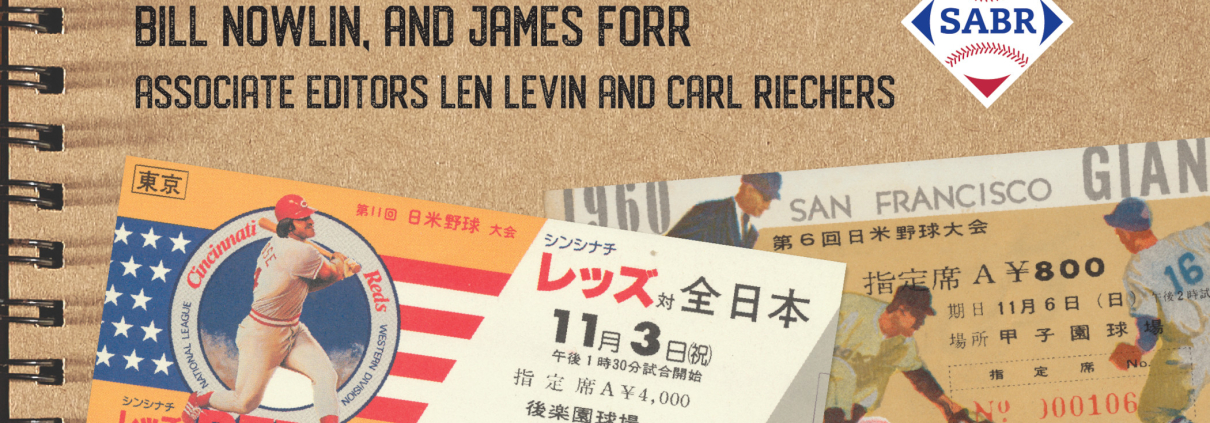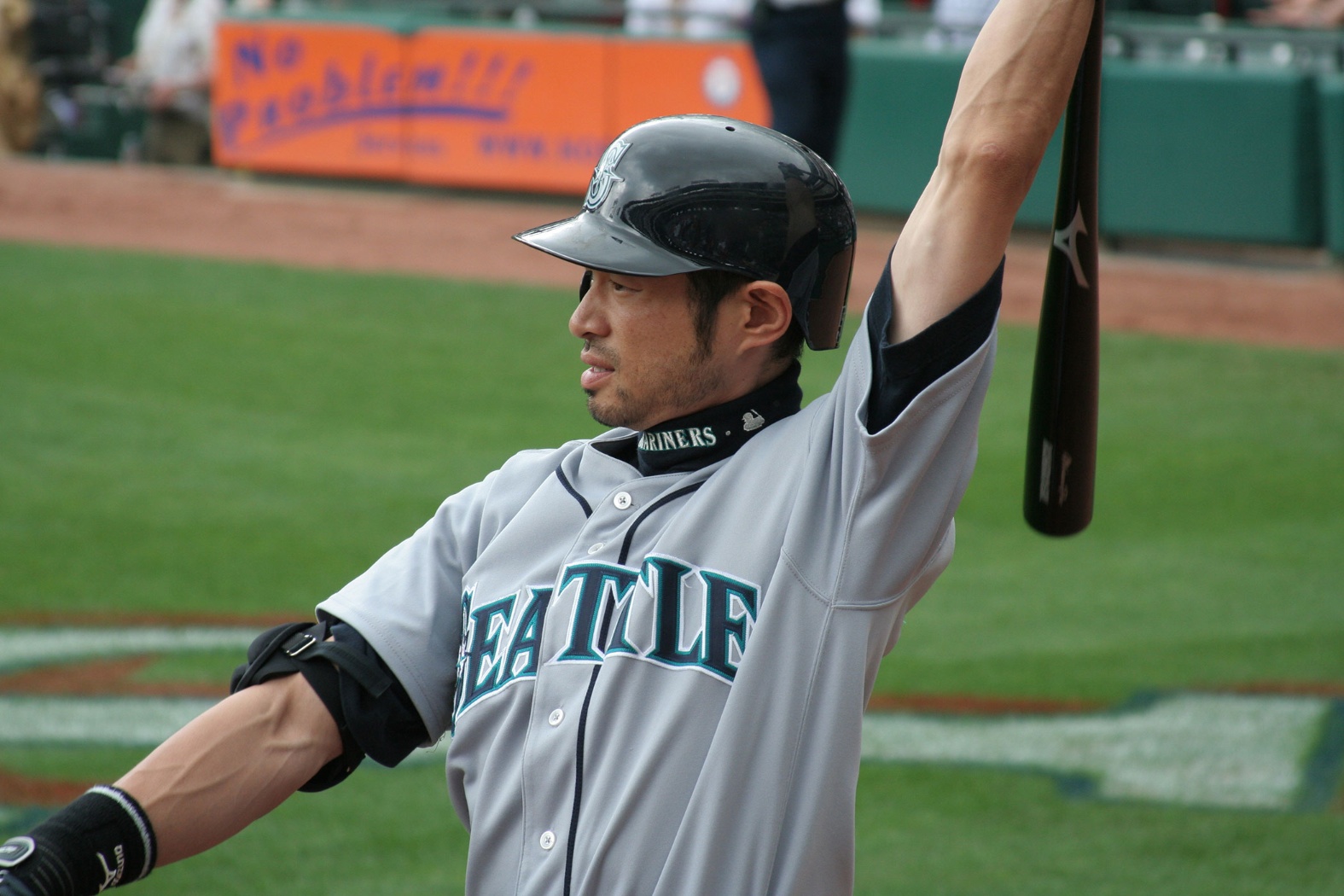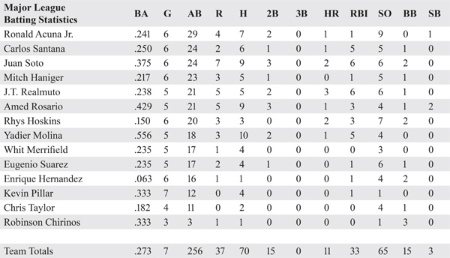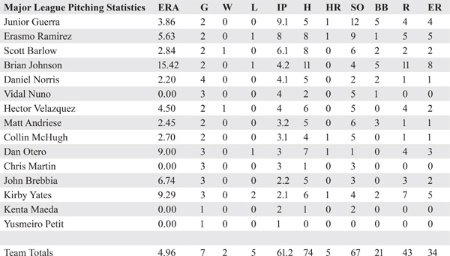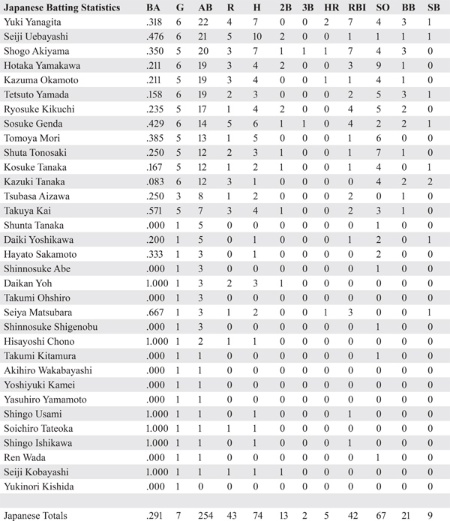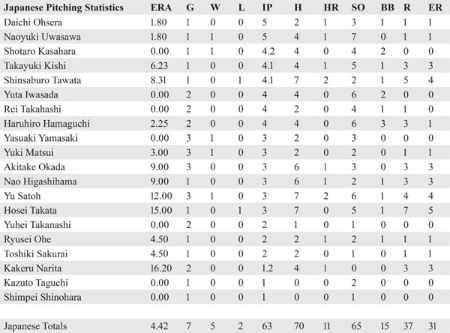Japan Dominates: The 2018 MLB All-Star Tour of Japan
This article was written by Susan Miyagi McCormac
This article was published in Nichibei Yakyu: US Tours of Japan, 1960-2019
Ichiro Suzuki of the Seattle Mariners. (Photo by Dave Wilkie)
Since baseball’s introduction to Japan in 1872, the Japanese game has evolved from being primarily an amateur sport with large fan bases for high-school and collegiate competitions to its teams being ranked tops in the world.1 Throughout the last 150 years, there have been varying opinions – from baseball authorities to casual fans – about Japanese players’ abilities to perform well in America’s pastime.
Cy Young, the major leagues’ all-time wins leader with 511, had disparaging remarks about Japanese players’ ability to pitch and hit, saying that they “will never become great players.”2
“Take the Japanese athlete. He can’t hit worth a hurrah,” Young said in 1910, one year before he pitched his last big-league game at the age of 44. “Every good pitcher has it on him. … A Jap can’t pitch. There is one reason for this, of course. That reason is that they can’t grip the ball. The hands of the Japs are very small. So small, in fact, that for one of them to grip the ball as the pitchers in this country grip it is impossible.”3
Newspapermen the following year echoed Young’s sentiment when the independent professional team known as the Japanese Base Ball Association barnstormed in the Midwest. In his 2020 book Issei Baseball: The Story of the First Japanese American Ballplayers, Robert Fitts documents the struggles and triumphs of Japanese immigrants who were dedicated to playing America’s pastime despite encountering financial hardships and intense discrimination throughout their travels across the United States. Although the press and spectators alike sometimes warmly received the Japanese teams, the criticism could be biting and downright racist. Fitts quotes a writer for the Hutchinson (Kansas) Daily Gazette as saying, “If the delegation of Japanese representing the baseball team in Hutchinson yesterday are considered high class Japanese baseball players, the Americans need to have no fear that the Orientals will rob us of the glory and excitement of our national pastime. … Owing to their small stature they are unable to cover as much ground as the Yankee, can’t throw nor can they think fast enough.”4 Three days later, a reporter from the Leavenworth (Kansas) Times wrote, “The game yesterday showed that baseball is a game which belongs to Americans.”5
Japanese professional baseball has made many strides since those early days of taking trains through the heartland of the United States, playing “America’s game” against any opponent who would face them. Masanori “Mashi” Murakami eventually pitched for the San Francisco Giants in 1964, becoming the first Japanese-born player in major-league history. There was a 30-year gap between Murakami and the next Japanese player, Hideo Nomo, but since then several of their countrymen have transitioned from NPB (Nippon Professional Baseball) to the major leagues to throw no-hitters (Nomo twice, in 1996 and 2001, and Hisashi Iwakuma in 2015), earn AL MVPs (Ichiro Suzuki and Shohei Ohtani), and win World Series (most notably Tadahito Iguchi, the first Japanese-born position player to do so; Hideki Matsui, who also earned World Series MVP honors as a New York Yankee in 2009; and pitchers Daisuke Matsuzaka, Hideki Okajima, and Koji Uehara, who won championships with the Boston Red Sox).
But for every Nomo and Ichiro and Matsui, there were the Kei Igawas, the Kazuo Fukumoris, and the Kenshin Kawakamis whose major-league careers were less than stellar. Many compared NPB to American baseball’s minor-league system, saying that NPB pitchers would have more of a chance to strike out Triple-A batters than the bigger, stronger major leaguers.
The wider baseball world started to realize the amount of considerable talent in the Far East when Japan won the first two installments of the World Baseball Classic, in 2006 and 2009. After collecting the Bronze Medal in the 2004 Summer Olympics in Athens, Samurai Japan captured Gold when Tokyo hosted the 2020 Summer Olympics, which was delayed until 2021 by the global COVID-19 pandemic. As of 2022, Japan was ranked the number-one baseball country in the world, according to the World Baseball Softball Confederation, the governing body for the sports of baseball, softball, and baseball5.6
Major leaguers have played exhibition games in Japan since 1908, and the major-league-Japan All-Star Series began in 1986.7 Historically, the major leaguers had no trouble winning almost all of those contests handily.8 The series took an eight-year break after 2006, since “the advent of the World Baseball Classic made the series in Japan somewhat redundant.”9
The friendly competition resumed in 2014, but with a slight change on the Japan side. Wanting to expose players to the best competition, NPB Commissioner Katsuhiko Kumazaki decided that rather than a team made up of NPB all-stars, Samurai Japan, the national team that represents the country in international contests like the Asian Baseball Championship, the World Baseball Classic, and the Olympics, would play the major leaguers.10 While there is overlap between a typical NPB all-star team and Samurai Japan, the members of the national team were carefully and thoughtfully chosen because their skills, experience, and – most important – their leadership deemed them “irreplaceable.”11
“We have been going after players, starting with camp scouting in February and watching games this season. In previous games with the US, players wore their respective pro team uniforms, but this time, they will be wearing the Japan uniform when competing with the MLB,” Samurai Japan manager Hiroki Kokubo explained during a press conference in July 2014. “We may have performed well in previous friendly games, but this game will be more of a true exhibition game. Focusing only on winning, playing a serious game.”12
The strategy worked against the MLB All-Stars; Samurai Japan won the 2014 series, 3 games to 2. This determination to build the perfect team that embodied Kokubo’s “Focus Only on Winning” mantra reverberated throughout NPB. Commissioner Kumazaki, who is considered to have played a major role in bringing baseball back to Olympic competition, wanted to continue to strengthen Samurai Japan after the team’s successful campaign in 2014. “We aspire to have our best team,” he said in August 2016, after baseball and softball were reinstated for the 2020 Games in Tokyo. “Our first priority is assembling a team that can win.”13
To Kumazaki, meaningful international competition was the ideal way to prepare Samurai Japan for the Olympics.14 His successor as commissioner, Atsushi Saito, shared his desire to turn Samurai Japan into Gold Medal winners. When MLB announced that an all-star team would return to Japan in 2018, Saito expressed gratitude for continuing the bilateral relationship between the two countries but made clear his primary objective in playing the major leaguers. “It has been four years since Samurai Japan and MLB last met. With our goal of winning a Gold Medal in the 2020 Olympic Games in Tokyo, this gives our players experience in high-level games against MLB players,” Saito said.15
With the 2018 MLB All-Star tour in Japan, Saito got the meaningful international competition he and Kumazaki wanted. Samurai Japan bested New York Yankees legend and Miami Marlins manager Don Mattingly’s MLB All-Star team, led by veteran Yadier Molina and featuring a host of young stars including Ronald Acuña Jr. and Juan Soto, in a six-game series held in Tokyo, Hiroshima, and Nagoya in November of that year.
Managing the Japanese national team was Atsunori Inaba, who had a 20-year playing career in NPB – a decade each with the Yakult Swallows and the Nippon-Ham Fighters – and was the MVP of the 2006 Japan Series and a member of the 2008 Olympic team that lost the Bronze Medal to the United States. He was also part of the 2009 WBC championship team as well as the 2013 team, which finished third. Retiring as a player in 2014, Inaba was on the coaching staff of Hiroki Kokubo’s 2017 Samurai Japan team that had another third-place finish in the WBC. He took over as manager of Samurai Japan in the summer of that year.
For the 2018 series against the MLB All-Stars, Inaba was fortunate to have a deep roster packed with players who perhaps were not household names to American fans but had accomplished careers in NPB. Among them were Rakuten Golden Eagles pitcher Takayuki Kishi, a four-time all-star who led the Pacific League with a 2.72 ERA in 2018; Shogo Akiyama, NPB’s all-time single-season hits leader (216 in 2015), who also earned multiple Golden Gloves while patrolling the outfield for the Seibu Lions; and Yuki Yanagita, who had just won another Japan Series championship with the SoftBank Hawks and earned Outstanding Player accolades less than a week before the series with MLB began.
Similarly, the MLB team was ready to compete with a lineup composed of highly respected talent. Along with the aforementioned Molina, Acuña Jr., and Soto, Mattingly had Reds standout Eugenio Suárez, AL stolen-base leader Whit Merrifield of the Royals, and 2017 World Series champion Collin McHugh of Houston to fortify his roster. There was even a Japanese native on the team.
Right-hander Kenta Maeda, who had a sparkling career for the Hiroshima Carp, compiling a 97-67 record with a 2.39 ERA and earning two Sawamura Awards (2010 and 2015), represented the MLB team as a member of the Los Angeles Dodgers. He became the 11th overall Japanese-born player to participate in the all-star tours as a member of the MLB team and the third since Samurai Japan was designated the opponent, following pitchers Hisashi Iwakuma and Tsuyoshi Wada, who both competed in 2014.16
Another Japanese-born defector to team MLB was Hideki Matsui. Beloved in Japan as one of the most popular players to don a Yomiuri Giants uniform, Matsui served as the MLB team’s first-base coach, wearing his familiar number-55 jersey, but with the interlocking NY logo. “It’s such a great thing that I’m back in Japan with this Yankees uniform on,” Matsui said in an article by Alyson Footer on MLB.com. “Even though I’ve never been a first-base coach before, which makes me overanxious, I’ll try not to hurt the team. I’ll try to contribute.”17
One of Matsui’s fellow MLB All-Stars coaches was Hensley Meulens, a Curaçao native who played for the Chiba Lotte Marines in 1994 and the Yakult Swallows in 1995 and 1996, winning the Japan Series in 1995. Another NPB connection on the MLB side was Chris Martin. The Texas Rangers pitcher spent two seasons as a reliever with the Nippon-Ham Fighters and a teammate of Shohei Ohtani. As a member of the 2016 Japan Series championship team, Martin had a 1.07 ERA and 21 saves and was named a Pacific League All-Star. The following season, he made 40 appearances and had a 1.19 ERA. “It would’ve been really, really cool to get to go back to Sapporo and play in Sapporo Dome,” Martin said of the 2018 tour. “I loved the fans there. Being here, though, is amazing, it’s a really cool experience.”18
Before the MLB All-Stars and Samurai Japan faced each other, they each played one friendly as a warm-up. First, on November 7, Samurai Japan lost to the Chinese Taipei National Team (referred to as Taiwan in Japanese newspapers19), 6-5, in the Fukuoka Yafuoku! Dome. Chinese Taipei’s starter, Chiang Chen-Yen, and four relievers held Samurai Japan scoreless through eight innings. Then Samurai Japan mounted a furious comeback, scoring all five of its runs in the bottom of the ninth.
Infielder Kosuke Tanaka led off the inning with a double and scored on Tetsuto Yamada’s RBI single. A single by designated hitter Yuki Yanagita and a walk to Kazuma Okamoto loaded the bases with one out. After pinch-hitter Takuya Kai struck out, Seiji Uebayashi reached on an error that scored a run. A third run crossed the plate on Kazuki Tanaka’s bases-loaded walk. Shuta Tonosaki had a two-run single to make the score 6-5, but the rally fell short as Kosuke Tanaka, who got the ball rolling with his leadoff double, struck out to end the game with two runners on base.20
Inaba thought the fact that his team scored five runs at the end of the game was a good sign moving forward, even though its efforts did not result in a victory. The momentum should carry over into the next game, he said.21 And it did.
But he would have to wait because the MLB team’s exhibition was the next night. The major leaguers fared better in their friendly, handing the hometown Yomiuri Giants a 9-6 loss in Tokyo Dome. Tatsunori Hara, the former Giants great who led the Japanese national team to the 2009 World Baseball Classic title, was back for his third stint as Yomiuri’s manager. He was rehired one month before the friendly with the MLB All-Stars. As a player, he spent his entire 15-year career with the Giants, winning the Central League Rookie of the Year award in 1981, the Central League MVP Award two years later, and three Japan Series championships. He also led the Giants to three Japan Series championships as their manager: 2002, 2009, and 2012.
After the victory Mattingly said his team used the exhibition game to shake off a month’s worth of rust.22 The Giants seemed to be a bit rusty themselves, especially on defense. They helped the All-Stars score with shortstop Hayato Sakamoto’s throwing error, which plated two runs in the top of the first inning.
Marlins slugger J.T. Realmuto powered the MLB All-Stars with an RBI double in the third and a solo home run in the fifth. Amed Rosario delivered a two-run single and Yadier Molina, who was the DH with Realmuto catching, added an RBI double to round out the major leaguers’ five-run third inning. Juan Soto, the Washington Nationals slugger who placed second in the 2018 National League Rookie of the Year voting to his All-Stars teammate Ronald Acuña Jr., drove in a run with an infield double off Tokyo Dome’s puffy white ceiling.
While Soto’s hit evoked images of fly balls clanking in the catwalk at Tropicana Field, the highlight of the game did not come from the MLB All-Stars.23 Instead, it came from an NPB player who hadn’t even had an NPB plate appearance. Seiya Matsubara was an ikusei, or nonroster developmental player, with Yomiuri until July 31, 2018.24 (In NPB, ikusei participate in minor-league games and wear jerseys with triple digits on their backs.) The Giants included him on their roster for the MLB friendly, five months before his first NPB season officially started. The 25-year-old came into the game in the fourth inning as a pinch-hitter and drove the first pitch he saw into the outfield, splitting Acuña Jr. and Soto. When all was said and done, Matsubara had a three-run, inside-the-park home run.
“It was my first ichi-gun (top team) at-bat, so of course I was nervous,” Matsubara, who also added a single in the sixth, said. “Since I joined the team last year, I was determined to make sure I would enjoy my first at-bat. That’s the way I approached it. I’m happy that [it] led to a good result.”25
The outcomes of MLB’s and Samurai Japan’s respective exhibition games did not indicate how the tour itself would go, as Samurai Japan won the six-game series 5 games to 1. By no means was this a beatdown; the games were competitive, some even requiring dramatic comebacks. And it started in Game 1.
With Samurai Japan trailing 6-4 with one out in the bottom of the ninth, Seiji Uebayashi singled, stole second base, and scored on a two-out single by Tsubasa Aizawa. Then SoftBank’s star center fielder, Yuki Yanagita, hammered a two-run, sayonara home run off MLB closer Kirby Yates to win the game 7-6 and give Samurai Japan a 1-0 lead in the series. “That’s what I’d like to emphasize to all my hitters,” Inaba said of the team’s perseverance in the final frame. “That we should be able to maintain a good situation from one hitter to another so that we will be able to score runs.”26
A solo home run by Amed Rosario in the third, a three-run shot by Carlos Santana in the fifth, and Juan Soto’s two-run blast in the sixth accounted for the All-Stars’ six runs. Shogo Akiyama, who had a bases-clearing double in the bottom of the fifth to tie the score at 4-4, said, “We never felt like we were out of it and knew if we stayed close, we’d have a chance to win.”27
Of his walk-off, Yanagita, who had a walk-off in Game Five of the Japan Series a week earlier, said, “It was a perfect shot.” He later added, “Hopefully I’ll be able to hit more.”28
Yanagita didn’t have to wait long: He was also the hero of Game 2, although late-inning theatrics were not required for this one. He and his teammates scored the first nine runs en route to a 12-6 drubbing of the MLB team at Tokyo Dome. With Samurai Japan the visiting team, Yanagita started the scoring with an RBI single in the top of the first off starter Erasmo Ramirez. In the bottom of the inning, the MLB All-Stars had runners on the corners but failed to score.
Yanagita hit a two-run home run in the third, also off Ramirez, and added another RBI single off Brian Johnson in Samurai Japan’s four-run fifth. Akiyama added three hits, including a triple, and three RBI. Starting for Samurai Japan, Naoyuki Uwasawa allowed one run – a solo shot by Juan Soto – on four hits with no walks and seven strikeouts over five innings.29
For the MLB All-Stars, J.T. Realmuto continued his hot hitting with a double and a three-run home run, while Kiké Hernández and Kevin Pillar each drove in a run. But it was not enough.30
“The entire lineup was able to string together hits,” Inaba said. “I think we are on the right track now, and I would like to see us continue to do the same in the game tomorrow.”31
They didn’t. The MLB All-Stars were finally able to hold off Samurai Japan to come away with a 7-3 Game 3 victory. Both teams were scoreless until the fourth inning. MLB struck first with a solo shot by Realmuto, who flipped DH/catcher duties with Yadier Molina. Molina caught the game and had a monster night at the plate, going 3-for-5 with a three-run homer. Rounding the bases, the veteran All-Star soaked in the atmosphere of Tokyo Dome. “It was a good feeling to experience that here in front of the Japanese fans,” Molina said. “There is a great crowd here tonight.”32
The crowd of 45,147, as well as the 40,000-plus at each of the first two games, impressed the MLB All-Stars, who were not accustomed to the heightened energy and specific chants for each Japanese player. Whit Merrifield of the Kansas City Royals said, “I was just enjoying it. Because it’s different than it is in the States. So, I was trying to learn the chants for the different guys.”33 Despite the roar of the crowd, Molina executed a defensive gem in the bottom of the fourth. Samurai Japan had runners on first and second with two outs, but Molina picked off Seiji Uebayashi at first base to end the inning.34 “We saw a big shift in the momentum in the game tonight in the fourth inning,” Inaba said. “Molina made a really good pickoff move to first base. We should’ve been much more careful.”35
There were no home runs for Yuki Yanagita on this night, just RBI doubles by Shuta Tonosaki, Hotaka Yamakawa, and Ryosuke Kikuchi to account for Samurai Japan’s three runs. Starter Scott Barlow earned the win for the MLB All-Stars after going 4⅓ innings with one run on five hits. Shinsaburo Tawata also went 4⅓ innings, giving up five runs – four earned – on seven hits for the loss.36
The Series traveled to Hiroshima for the fourth game and a matchup of two Carp, one current and one former. The current Carp was Daichi Ohsera, who pitched five innings of two-hit, one-run ball. The only blemish on his ledger was a solo home run by Rhys Hoskins in the second inning. The former Carp was Kenta Maeda, who was a five-time NPB All-Star during his eight years in Hiroshima. The current Dodgers pitcher threw two scoreless innings to start the game against his countrymen, some of whom were his former Carp teammates.
Once again, Samurai Japan found itself in comeback mode in the ninth inning, but this time, according to the Kyodo News, was “the purest expression of Japan’s game.”37 The Japanese were the visitors and down two runs. Kazuki Tanaka led off the top of the ninth with a walk issued by Kirby Yates, stole second, and scored on a single by Seiji Uebayashi, who eventually scored after a sacrifice by catcher Tsubasa Aizawa and a base hit by Kosuke Tanaka, tying the game, 3-3. Kosuke Tanaka also stole second base and went to third on a throwing error by J.T. Realmuto. An intentional walk to Shogo Akiyama, who had hit an inside-the-park home run in the eighth, brought Ryosuke Kikuchi to the plate to face John Brebbia, on in relief of Yates. A safety squeeze by Kikuchi brought home Kosuke Tanaka, the go-ahead run. A passed ball moved Kikuchi to second and Akiyama to third, and Yuki Yanagita drove Akiyama home with a groundout. Now with a 5-3 lead, Yasuaki Yamasaki gave up one hit but otherwise shut down the MLB All-Stars for the save.38
With a 3-1 lead in the Series, Samurai Japan would move on to host the MLB All-Stars at the Nagoya Dome for Game 5. Another game, another come-from-behind victory for Samurai Japan, and this one clinched the series, 4 victories to 1. Rhys Hoskins, who had hit a home run the previous night in Hiroshima, started the scoring with a two-run blast off starter Nao Higashihama in the top of the second. Ronald Acuña Jr. doubled and scored on Juan Soto’s single in the third, and Yadier Molina made it 4-1 in the next inning when he doubled home Amed Rosario. The speedy Rosario made it 5-1 in the sixth. He singled and stole second, and Carlos Santana drove him home with a two-out RBI single.39
MLB’s pitching was stellar through six innings. Junior Guerra of the Brewers gave up one run on one hit – a solo home run by Kazuma Okamoto – and struck out seven through five innings before handing the ball over to Hector Velazquez, who pitched a perfect sixth.40
Samurai Japan staged its comeback in the seventh, taking advantage of a costly error by Velazquez. Okamoto scored on an RBI single by Takuya Kai, making the score 5-2. In an attempt to start what should have been an easy double play, Velazquez threw a comebacker from Kazuki Tanaka into center field, scoring Seiji Uebayashi. With Kai on second and Tanaka on first, pinch-hitter Hotaka Yamakawa tied the game, 5-5, with a two-run double.41 The next inning, Kai again came through with an RBI double that Acuña Jr. bobbled, allowing Uebayashi to race home from first.42
Another botched double-play chance ended the game in a strange way. Mitch Haniger grounded the ball to shortstop Sosuke Genda, who tossed it to second baseman Tetsuto Yamada to retire Kevin Pillar. Yamada’s throw to first was wide and wild. Catcher Takuya Kai backed up the throw in foul territory and fired it back to Yamada, who tagged out Haniger to end the game.43 Samurai Japan won another wild one, 6-5, and the series. Even with the series in hand, Samurai Japan needed to face the MLB All-Stars the next night for the sixth and final game.
Twenty-three-year-old Chunichi Dragons pitcher Shotaro Kasahara started Game 6 in his home ballpark, the Nagoya Dome. He retired the first six batters he faced and threw 4⅔ innings of four-hit, no-run baseball to earn the 4-1 victory. Samurai Japan scored all the runs it needed in the top of the second.44
MLB starter Brian Johnson walked Hotaka Yamakawa to lead off the inning and then loaded the bases by allowing singles to catcher Tomoya Mori and left fielder Shuta Tonosaki. A triple by shortstop Sosuke Genda cleared the bases and brought Johnson’s night to an early end. His replacement, Erasmo Ramirez, gave up a sacrifice fly to second baseman Ryosuke Kikuchi that scored Genda.45
Acuña Jr. scored the MLB All-Stars’ lone run, an eighth-inning home run off Kasahara’s Dragons teammate Yu Satoh. Satoh was in a bases-loaded, one-out jam but struck out Robinson Chirinos and Chris Taylor to end the inning and prevent further damage. Yasuaki Yamasaki pitched a one-two-three ninth inning for the save.
Since 1986 there have been 12 All-Star series, and the five wins in 2018 are the most for a Japanese team.46 It was the second consecutive time that the Japanese national team, rather than a team of NPB all-stars, faced the MLB All-Stars, and Samurai Japan won both meetings. Prior to that, the MLB All-Stars had a 9-1 series lead. Perhaps more significant, Saito’s and Kumazaki’s dreams of Olympic Gold came true three years later in Tokyo, as Samurai Japan fittingly defeated the US team, 2-0. Several stars from the 2018 series contributed to Samurai Japan’s success in 2021, including Tetsuto Yamada and Yuki Yanagita.
While the series are competitive and help both sides prepare for other international contests like the World Baseball Classic or the Olympics, a key component of the tours is the cultural exchange and fostering of goodwill and understanding between the two countries. When the 2018 series moved to Hiroshima, Don Mattingly, Kenta Maeda, and Mitch Haniger visited Hiroshima Peace Memorial Park. Mattingly laid a wreath at the Cenotaph for the Victims of the Atomic Bomb in memory of the lives lost to the atomic bombing of the city during World War II.47
“Personally, it’s humbling to stand in front of the memorial and also an honor to be here as part of MLB to represent our game and bring our two countries and two leagues together to be able play in this great city,” Mattingly said.48
On a lighter note, the MLB delegation was happy to interact with fans, signing autographs and giving away bats, shoes, hats, and T-shirts.49 Some players, such as Rhys Hoskins and Whit Merrifield, took it a step further and immersed themselves in the culture, documenting their off-field experiences on social media as they visited tourist attractions, sampled food, and dressed in kimonos. Hoskins tweeted, “Confirmed: the Tokyo Fish Market has the best tuna you will ever have.”50
Lighthearted moments and serious competition have become hallmarks of the MLB-Japan series. It’s become increasingly clear that baseball isn’t simply America’s game; it’s the international pastime.
SUSAN MIYAGI McCORMAC is the main graphics operator for the YES Network’s Emmy Award-winning television broadcasts of New York Yankees baseball games. In 2004 she traveled to Tokyo to work the Opening Series between the Yankees and Devil Rays. As a result of that experience, her passing interest in Japanese baseball blossomed into ardent fandom. She’s attended dozens of NPB games in Japan as well as the 2012 Opening Series between the Seattle Mariners and the Oakland Athletics with JapanBall, an international baseball tourism group. Susan’s love of Japanese baseball has strengthened her connection to her Japanese roots. She lives in New York City, where she runs the website JapanCulture-NYC.com and serves on the boards of the Japanese American Association of New York and the JET Alumni Association of New York, the advisory board of the OIST Foundation, and the communications committee of the New York region of the U.S.-Japan Council.
Notes
1 Daniel A. Métraux, “Baseball in Japan and the US: History, Culture, and Future Prospects,” Education About Asia 21, no. 2 (Fall 2016): 42.
2 “Japs Will Never Shine in Baseball,” Altoona (Pennsylvania) Tribune, February 22, 1910: 2.
3 “Japs Will Never Shine in Baseball.”
4 Robert K. Fitts, Issei Baseball: The Story of the First Japanese American Ballplayers (Lincoln: University of Nebraska Press, 2015), 177.
5 Fitts, 178.
6 “New WBSC Baseball World Rankings: Japan Remains No. 1, Chinese Taipei Rises to No. 2.” WBSC.org, January 20, 2022. https://rankings.wbsc.org/news/new-wbsc-baseball-world-rankings-japan-remains-no-1-chinese-taipei-rises-to-no-2. “Baseball5” is a street version of baseball/softball that the WBSC launched in 2017 to make the game more accessible to everyone, especially youth in underserved communities. It is a five-inning, five-on-five game that is played in urban areas with only a rubber ball; participants hit the ball with their hands. https://baseball5.wbsc.org/.
7 “Major League Baseball Returns to Japan in 2018 and 2019,” MLB.com, May 1, 2018. https://www.mlb.com/press-release/major-league-baseball-returns-to-japan-in-2018-and-2019-274713114.
8 “History: Teams Visiting Japan.” MLB.com. http://mlb.mlb.com/mlb/events/japan_series/history.jsp?content=history_teams.
9 Anthony DiComo, “Everything You Need to Know About Japan All-Star Series,” MLB.com, November 7, 2014. https://www.mlb.com/news/japan-all-star-series-faq/c-100799976.
10 DiComo; Samuel Chi, “Samurai Japan Take on the MLB All-Stars … and Win,” The Diplomat, November 20, 2014. https://www.wbsc.org/en/news/new-world-no-1-samurai-japan-no-hits-mlb-all-stars-in-tokyo.
11 Samurai Japan Conference Report, “Press Conference with Six Members of ‘Samurai Japan’s’ Top Team,” Official Website of the Japan National Baseball Team, July 17, 2014. https://www.japan-baseball.jp/en/news/special/20140717_1.html.
12 Samurai Japan Conference Report.
13 Kyodo News, “NPB Wants ‘Best Athletes’ to Compete in 2020 Olympic Baseball Tournament,” Japan Times, August 4, 2016. https://www.japantimes.co.jp/sports/2016/08/04/baseball/japanese-baseball/npb-wants-best-athletes-to-compete-in-2020-olympic-baseball-tournament/.
14 Kyodo News, “NPB Eyes ‘Meaningful’ International Games to Bolster National Team Run-Up to 2020 Olympics,” Japan Times, January 5, 2017. https://www.japantimes.co.jp/sports/2017/01/05/baseball/japanese-baseball/npb-eyes-meaningful-international-games-bolster-national-team-run-2020-olympics/.
15 “Major League Baseball Returns to Japan in 2018 and 2019.”
16 Jon Paul Morosi, “Maeda Wants to Pitch for MLB All-Stars in Japan,” MLB.com, June 30, 2018. https://www.mlb.com/news/kenta-maeda-wants-to-represent-mlb-in-japan-c283637802.
17 Alyson Footer, “Matsui’s Star Still Shines Brightly in Japan,” MLB.com, November 9, 2018. https://www.mlb.com/news/hideki-matsui-first-pitch-mlb-japan-tour-c300485704.
18 Jason Coskrey, “Rangers Pitcher Chris Martin Happy to Return to Japan with MLB All-Stars,” Japan Times, November 10, 2018. https://www.japantimes.co.jp/sports/2018/11/10/baseball/rangers-pitcher-chris-martin-happy-return-japan-mlb-stars/.
19 When communism took hold in China in 1949, the overthrown Nationalist government fled to the island of Taiwan. To this day, the People’s Republic of China still considers Taiwan, whose official name is the Republic of China, as part of its territory under the “One China Policy,” but Taiwan’s democratic government maintains that it is a sovereign nation. However, to participate in international events and athletic competitions such as the Olympics, Taiwan agreed in 1981 to compete under the name Chinese Taipei, two years after the executive committee of the International Olympic Committee passed a resolution readmitting mainland China into the IOC. News outlets in Japan, which colonized Taiwan from 1895 until the end of World War II, referred to the team as Taiwan rather than Chinese Taipei during the friendly against Samurai Japan in 2018 and during the opening ceremony of the 2020 Tokyo Olympics in July 2021.
Lindsay Maizland, “Why China-Taiwan Relations Are So Tense,” Council on Foreign Relations, August 3, 2022. https://www.cfr.org/backgrounder/china-taiwan-relations-tension-us-policy-biden. Meredith Oyen, “Why Is Taiwan Competing in the Olympics Under ‘Chinese Taipei’?” UMBC Magazine, February 2, 2022. https://umbc.edu/stories/why-is-taiwan-competing-in-the-olympics-under-chinese-taipei-3/. Keoni Everington, “Japanese TV Lists Taiwan’s Baseball Team as ‘Taiwan,’ not ‘Chinese Taipei,’” Taiwan News, November 8, 2018. https://www.taiwannews.com.tw/en/news/3570783.
20 Jason Coskrey, “Japan Falls to Taiwan in Warm-Up for MLB All-Star Series,” Japan Times, November 7, 2018. https://www.japantimes.co.jp/sports/2018/11/07/baseball/japanese-baseball/japan-falls-taiwan-warm-mlb-star-series/.
21 Coskrey, “Japan Falls to Taiwan in Warm-Up for MLB All-Star Series.”
22 Jason Coskrey, “MLB All-Stars Jump on Giants Early En Route to an Exhibition Victory,” Japan Times, November 8, 2018. https://www.japantimes.co.jp/sports/2018/11/08/baseball/japanese-baseball/mlb-stars-jump-giants-early-en-route-exhibition-victory/.
23 Edward Sutelan, “Tropicana Field Ground Rules, Explained: Why Home Runs Count When They Hit the Catwalk at Rays’ Stadium,” The Sporting News, October 9, 2021. https://www.sportingnews.com/ca/mlb/news/tropicana-field-ground-rules-home-runs-catwalk-rays/12a0nmh6953g5119v61l371826.
24 Ryo Shinkawa, “Ikusei (Training) Player System,” NPBTracker.com, May 13, 2009. http://www.npbtracker.com/2009/05/ikusei-training-player-system/.
25 Coskrey, “MLB All-Stars Jump on Giants Early En Route to an Exhibition Victory.”
26 Jason Coskrey, “Samurai Japan’s Yuki Yanagita Delivers Ninth-Inning Heroics in Japan All-Star Series Opener,” Japan Times, November 10, 2018. https://www.japantimes.co.jp/sports/2018/11/10/baseball/samurai-japans-yuki-yanagita-delivers-ninth-inning-heroics-japan-star-series-opener/.
27 Jim Armstrong, “Yanagita’s HR Off Yates Lifts Japan Over MLB in Tour Opener,” APnews.com, November 9, 2018. https://apnews.com/article/8039ae98010e4d1e90f2c61038463f92.
28 Coskrey, “Samurai Japan’s Yuki Yanagita Delivers Ninth-Inning Heroics in Japan All-Star Series Opener.”
29 Associated Press, “Japan Beats MLB All-Stars 12-6 to Take 2-0 Series Lead,” USAToday.com, November 10, 2018. https://www.usatoday.com/story/sports/mlb/2018/11/10/japan-beats-mlb-all-stars-12-6-to-take-2-0-series-lead/38465453/.
30 Jason Coskrey, “Samurai Japan’s Yuki Yanagita Wields Powerful Bat in Game 2 Victory Over MLB All-Stars,” Japan Times, https://www.japantimes.co.jp/sports/2018/11/10/baseball/samurai-japans-yuki-yanagita-wields-powerful-bat-game-2-victory-mlb-stars/, November 10, 2018.
31 Associated Press, “Japan Beats MLB All-Stars 12-6 to Take 2-0 Series Lead.”
32 Jason Coskrey, “Yadier Molina, J.T. Realmuto Go Deep as MLB Stars Dominate Game 3,” Japan Times, November 11, 2018. https://www.japantimes.co.jp/sports/2018/11/11/baseball/yadier-molina-j-t-realmuto-go-deep-mlb-stars-dominate-game-3/.
33 Kaz Nagatsuka, “Japanese Fans Providing New Experience for Major Leaguers,” Japan Times, November 12, 2018. https://www.japantimes.co.jp/sports/2018/11/12/baseball/japanese-fans-providing-new-experience-major-leaguers/.
34 Coskrey, “Yadier Molina, J.T. Realmuto Go Deep as MLB Stars Dominate Game 3.”
35 Coskrey, “Yadier Molina, J.T. Realmuto Go Deep as MLB Stars Dominate Game 3.”
36 Coskrey, “Yadier Molina, J.T. Realmuto Go Deep as MLB Stars Dominate Game 3.”
37 Kyodo News, “Samurai Japan Stages Another Ninth-Inning Comeback Victory Against MLB All-Stars,” Japan Times, November 13, 2018. https://www.japantimes.co.jp/sports/2018/11/13/baseball/samurai-japan-stages-another-ninth-inning-comeback-victory-mlb-stars/.
38 Kyodo News, “Samurai Japan Stages Another Ninth-Inning Comeback Victory Against MLB All-Stars.”
39 Ed Eagle, “Largest Comeback Gives Japan Series Win vs. MLB,” MLB.com, November 14, 2018. https://www.mlb.com/news/japan-beats-mlb-with-another-late-comeback-c300680096.
40 Eagle.
41 Eagle.
42 Eagle.
43 Eagle.
44 Kyodo News, “Sosuke Genda Powers Samurai Japan Past MLB All-Stars in Series Finale,” Japan Times, November 15, 2018. https://www.japantimes.co.jp/sports/2018/11/15/baseball/sosuke-genda-powers-samurai-japan-past-mlb-stars-series-finale/.
45 Kyodo News, “Sosuke Genda Powers Samurai Japan Past MLB All-Stars in Series Finale.”
46 Kyodo News, “Sosuke Genda Powers Samurai Japan Past MLB All-Stars in Series Finale.”
47 Associated Press, “MLB All-Stars Visit Hiroshima Peace Memorial Park,” USAToday.com, November 12, 2018. https://www.usatoday.com/story/sports/mlb/2018/11/12/mlb-all-stars-visit-hiroshima-peace-memorial-park/38483843/.
48 Associated Press, “MLB All-Stars Visit Hiroshima Peace Memorial Park.”
49 Alyson Footer, “MLB Stars Leave Japan with Lifetime of Memories,” MLB.com, November 15, 2018. https://www.mlb.com/news/mlb-japan-wrap-up-series-with-mutual-respect-c300750878.
50 Adrian Garro, “Rhys Hoskins and Whit Merrifield Starred in Their Own Mini-Travel Show, Enjoying the Sights (and Food) of Tokyo, Cut4 by MLB.com, November 10, 2018. https://www.mlb.com/cut4/rhys-hoskins-and-whit-merrifield-go-out-on-the-town-in-tokyo-c300546206.
51 These tables include all participants in the series including the game against the Yomiuri Giants. “Nichibei Yakyu Batting and Pitching Statistics,” Sports Hochi, November 16, 2018: 2; Nippon Professional Baseball Records, https://www.2689web.com/nb.html; “Japan All-Star Series 2018,” https://npb.jp/japanus/2018/.


